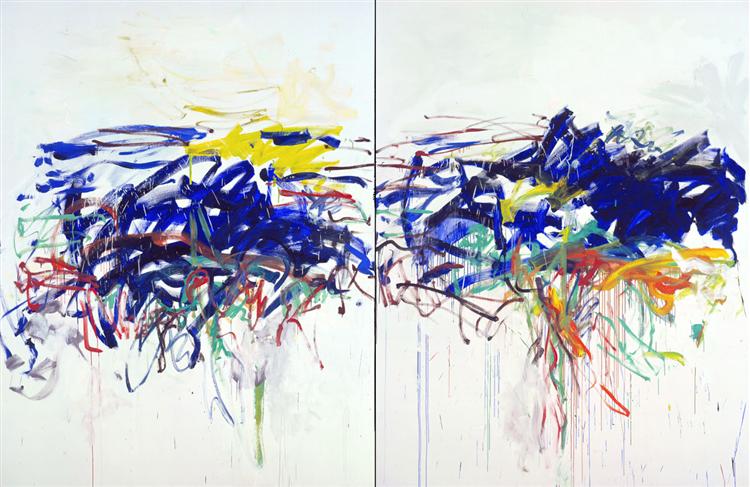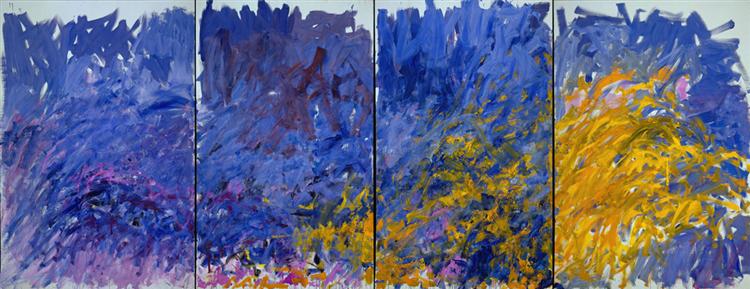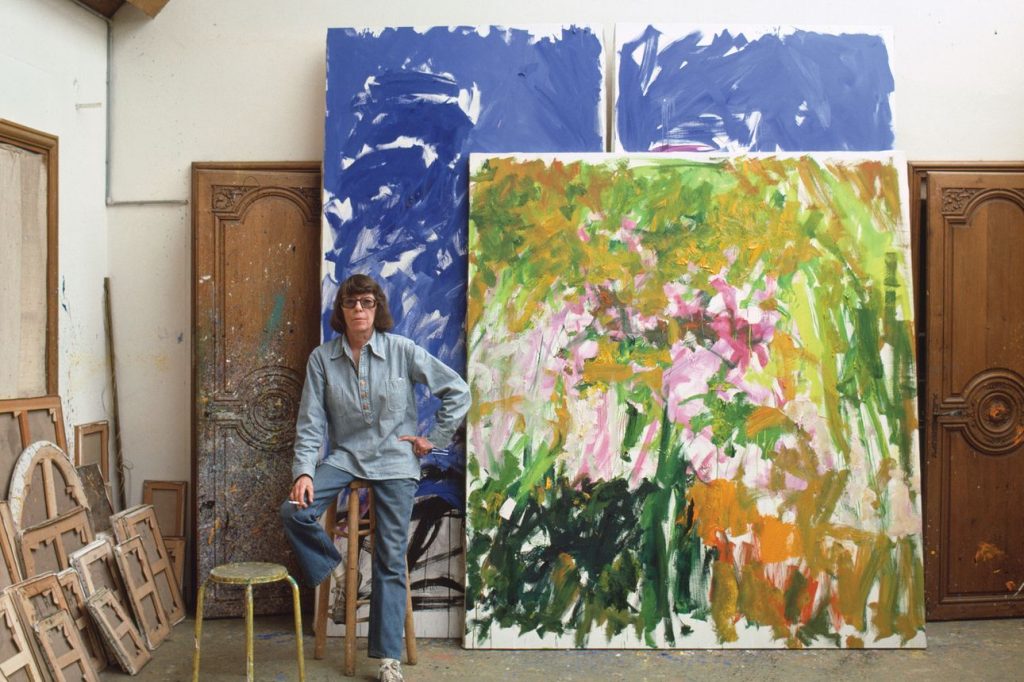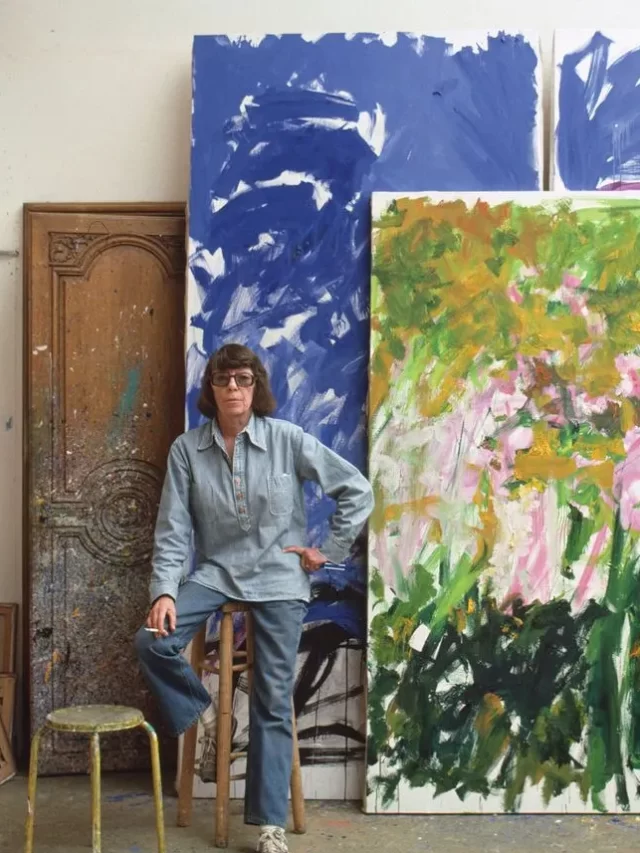Joan Mitchell was a hugely influential artist in Western art, especially in the Abstract Expressionist style. Her birthplace was Chicago, and she earned a BFA from the Art Institute of Chicago in 1947. She participated in the vibrant early 1950s downtown New York art scene, spending time with many other painters and poets. She began painting in the Abstract Expressionism style in New York. She went to Paris, France, in 1955, and from the metropolis, she moved in 1967 to a house in the little hamlet of Vétheuil, near Paris. At Vétheuil, she had more space to paint and was surrounded by the outdoors.
Mitchell’s home overlooked the Seine River from its hilltop location. The property included expansive trees and gardens where she grew various plants and flowers, sunflowers being her favourite. Joan cherished her dogs so much that many of her paintings have their names. She had many pets over her lifetime. Joan Mitchell painted for the rest of her life. She produced drawings, especially in pastel and watercolour, and used several printmaking techniques in addition to oil paintings. Mitchell died in 1992.
Art of Joan Mitchell

Mitchell was a member of the post-World War II American movement known as the second generation of Abstract Expressionists. She worked with artists like Jackson Pollock, Willem de Kooning, and Mark Rothko to define and establish this revolutionary painting movement. Mitchell’s vivid colours and forceful, expressive brushstrokes set his artwork apart. She was well known for her expressive and vibrant use of paint, which frequently conveyed a sense of movement and intensity. Her drawings are vivid and lifelike, wonderfully capturing her mood and surroundings.
Mitchell drew inspiration from the natural world, particularly from the landscapes of her native Midwest and her subsequent experiences living in France. Her abstract works often convey the feeling of natural occurrences, such as flowers, landscapes, and weather patterns, without showing them. Mitchell paints with intense intimacy and emotion. She famously remarked, “I carry my landscapes around with me,” illustrating how much her surroundings influenced her art. Her compositions often evoke emotions, from joy and vitality to introspection and melancholy.
Throughout her career, Mitchell encountered several difficulties and barriers as a woman in the male-dominated field of painting. She was nevertheless quite successful and well-known for her contributions. Feminist art historians and female artists alike hail Mitchell as a trailblazer in the struggle for gender parity in the arts, and her talents serve as an inspiration. It’s impossible to overestimate Mitchell’s influence on artists of later generations. Numerous painters have been influenced by her audacious, gestural manner, and her legacy is now honoured in publications, exhibitions, and scholarly research. She is still regarded as a titan in the annals of 20th-century art, her contributions to Abstract Expressionism and her unique aesthetic vision.
Joan Mitchell: Remembering in Color
[Joan was] Tough, vulnerable, loving, bawdy, bullying, embattled, generous, and enraged; she was as singular as her art, writes Patricia Albers in her book, ‘Joan Mitchell: Lady Painter’. According to the author, ‘The first time you meet her, she might insult you, even make you cry, but later, she might be so understanding and nurturing that she feels like a soulmate. Moreover, Joan sometimes made strange comments, which people tended to chalk up to drunkenness (she was a prodigious drinker) metaphor or the mark of the artistic personality. For instance, she described her painting as a ‘sort of scaffolding made of painting stretchers around a lot of coloured chaos’.

According to Albers, Joan was the artist who, according to her book, had a neurological condition that caused her to be highly colourful when she painted: “Joan’s synesthesia and eidetic memory, I realised, left their tracks all over her art.” That she was merely a primitive who transferred her brain experience onto canvas is not what I wish to say. Instead, Joan, the master painter, made use of every skill she possessed as well as every shred of experience she could muster, including the perceptual “otherness” that enabled her to open a window beyond the small opening of ordinary consciousness and produce works of art with an uncommon incandescence.
As stated, the theoretical foundation of modernism, particularly abstract expressionism, provides her with a thorough clash between theory and practice. She did not create a new ism. She was a master colourist. Thus, her work was formally unique and demonstrated “an original relation to the universe,” as essayist and philosopher Ralph Waldo Emerson put it.
American poet John Yau describes Joan as an angel of colour by placing her in a fantastical world and saying, ‘Whether in the French countryside, in New York City, or in Paris, the inquisitive, dynamic, nuanced, and brilliant internal discussions Mitchell had with different artists in her studio eventually resulted in their departure, enabling her to forge onward on her own. More crucially, she established her domain and gathered her repertoire of painting possibilities when she started painting freely and impulsively about 1951–1952. Mitchell never took orders. Her paintings are not like the gestural works of Kline or de Kooning. She found inspiration in their work and that of artists such as Adolph Gottlieb and Mark Rothko.

Are you at risk? As Joan consistently asserted, “No one can paint—write, feel whatever without being vulnerable,” this question remains unanswered. It also takes a lot of strength to be weak. Consider it. John Yau asserted in his brief remark that Joan Mitchell explored thematic regions that even de Kooning and Kline never did, and he noted the show, “Joan Mitchell: I carry my landscape around with me.” John Yau noted that Mitchell’s method is simple: she applies a specific colour with a particular brush. She modifies the paint’s brush, colour, and viscosity as she moves across the canvas. She never attempts to undo or erase what she has done. She doesn’t turn around and continues forward.
Because Joan Mitchell served as a trailblazer for the Abstract Expressionist movement, which fundamentally altered our perception of and relationships with paintings, her importance in the art world cannot be overstated. Mitchell’s imaginative use of colour, gesture, and shape filled her work with a vibrancy and emotion that still captivates audiences today.
Her exploration of the natural world and surroundings, combined with her highly analytical and introspective painting approach, resulted in a fantastic body of work that is incredibly affecting. The fact that Mitchell became a feminist icon by shattering stereotypes and expectations in the male-dominated art world only emphasises her legacy’s importance.
An Evening with Joan Mitchell, Who Carries The Landscape Within






